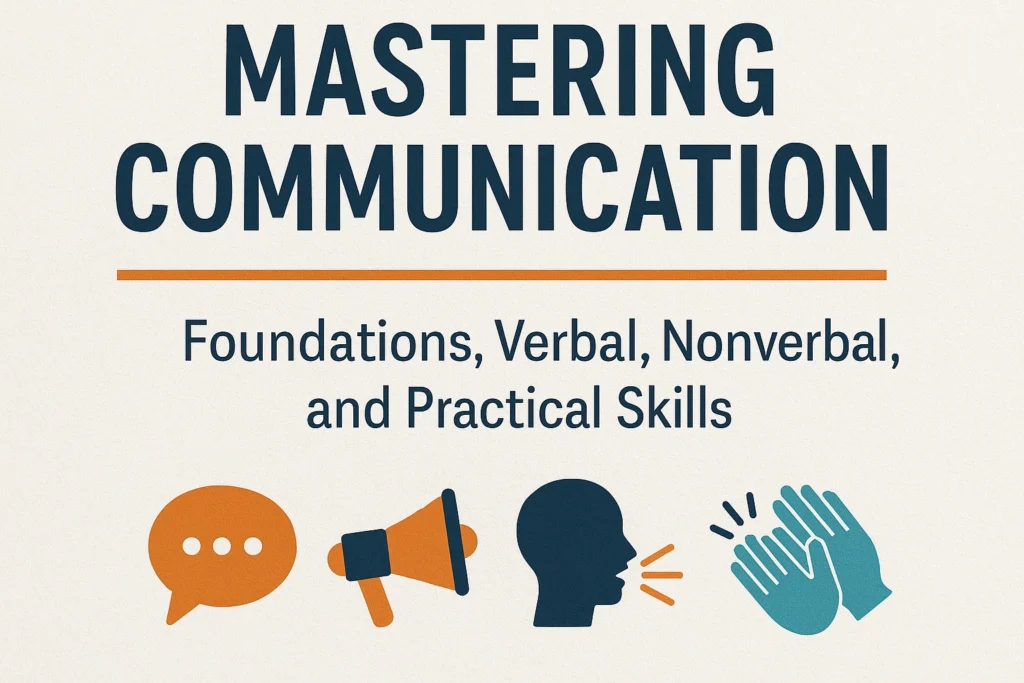Table of Contents
ToggleMastering Communication: Foundations, Verbal, Nonverbal, and Practical Skills

The Superpower of Effective Communication
This summarizes key areas and essential concepts from the RiseofAgentic "Complete Communication Skills Course" excerpts, highlighting its critical role in personal and professional spheres.
1. The Foundational Importance of Communication
The course emphasizes that "how you communicate is just as important as what you say." Communication is a "superpower" crucial for leading teams, presenting ideas, building relationships, and achieving success.
Key Concepts: Definition & Purpose
At its core, "communication is the act of conveying information, ideas, thoughts and emotions between individuals." It's a "complex and dynamic process" involving both verbal and nonverbal elements, with the primary goal to ensure the "intended message is received, understood and acted upon by the recipient."
Communication serves diverse purposes, including to "inform, persuade, entertain and express emotions." The intent dictates the "tone and method," whether providing instructions in a workplace or expressing empathy in a personal relationship.
Key Concepts: Impact
Effective communication "builds trust, fosters deeper connections, improve collaboration and boost overall productivity." Conversely, "poor communication often results in misunderstandings, delays and conflicts that can harm relationships and hinder progress." In today's world, effective communication is "not just helpful it's essential for both personal development and career success."
Forms of Communication: Verbal
Verbal Communication: Includes "spoken words and written messages." It is the "most direct form" for sharing information and ideas. The clarity and precision of verbal communication are paramount for effective message delivery.
Forms of Communication: Nonverbal & Visual
Nonverbal Communication: "Often overlooked," this refers to "body language, facial expressions, gestures, posture and even silence." These cues "can often carry more meaning than the words we speak as they reveal our true emotions and attitudes."
Visual Communication: Involves "using images, charts, graph and videos to convey messages," particularly important in "presentations and marketing" for enhancing understanding and engagement.
2. The Communication Process: A Two-Way Street
Communication is presented as a "dynamic process involving multiple steps," rather than a "one-way street." Understanding its elements is "key to mastering effective communication."
Key Elements: Sender, Message, Encoding, Medium
- Sender: The "individual or entity who originates the message," responsible for "encoding the message clearly and appropriately."
- Message: "The content that is being communicated," which "must be clear, concise and relevant."
- Encoding: The process where the sender "translates their thoughts... into format that can be communicated," choosing "the right words right symbols or the actions."
- Medium: "The method by which the message is being transmitted" (e.g., face-to-face, email). The choice "can affect how the message is being perceived."
Key Elements: Receiver, Decoding, Feedback
- Receiver: The "individual or group who receives the message," who must be "attentive, open-minded and engaged" for accurate understanding.
- Decoding: Once received, the receiver "must decode it or interpret it," processing information and "translating it back into the meaning."
- Feedback: The "response from the receivers's back to the sender," indicating "whether the message was understood as intended." It can be verbal or non-verbal and allows the sender to "gorge the effectiveness of the communication and make adjustments."
Key Element: Noise
Noise: "Any external or internal factors that can distort or interfere with the communication process." Noise can be "physical (background noise), psychological (biases, prejudices) or semantic (misunderstanding of words)." Reducing noise is "essential for clear communication" to ensure the message is received as intended.
3. Barriers to Effective Communication and How to Overcome Them
Various "barriers can occur at any stage of the communication process," hindering clarity. Identifying and overcoming these is "crucial for improving communication skills."
Types of Barriers
- Physical Barriers: Environmental factors like "background noise, poor phone or internet connections or even physical distance."
- Language Barriers: "Language differences or technical jar can create misunderstandings."
- Psychological Barriers: Factors like "stress, emotions or personal biases" affecting message interpretation.
- Cultural Barriers: "Cultural differences can impact how messages are conveyed and understood," including gestures, tone, and silence.
- Perceptual Barriers: "Perceptions and assumptions about the sender or the message can distort communication."
- Emotional Barriers: "Emotional states such as anger, fear or frustration can make it difficult to communicate effectively."
- Information Overload: Being "constantly bombarded with information," leading to missed key messages.
- Lack of Feedback: When "feedback is not provided the sender has no way of knowing whether the message was understood correctly."
Strategies to Overcome Barriers
- Clarify the message: "Make sure that your message is clear and concise."
- Active Listening: "Focus on the speaker avoid interrupting and reflect back what you have heard."
- Empathy: "Be sensitive to the emotions and perspective of others."
- Feedback: "Always seek feedback and provide it."
- Adaptation: "Be willing to adapt your communication style based on the context the medium and the audience."
4. Mastering Verbal Communication Skills
Verbal communication, encompassing spoken words, tone, and pitch, is fundamental to effective interaction and conveys significant meaning.
The Power of Words
Words are "powerful tools that can influence, motivate, inspire and even hurt." The choice of words "can shape the nature of our relationships and impact our success." Positive framing (e.g., "This is a challenge we can work through together") fosters hope, while negative framing ("this is a problem we might not be able to solve it") emphasizes difficulty. "Words are powerful."
Tone and Pitch
- Tone: Refers to the "emotional quality or attitude behind a speaker's voice." It "conveys feelings such as happiness, sadness, anger, excitement or calmness" and determines "how the message is received and how it is interpreted." A "warm and genuine tone" conveys sincerity, while a "monotone or indifferent tone" can sound apathetic.
- Pitch: Refers to the "highness or leeness of a person's voice." A "vary pitch is more likely to engage the listener," while a "flat or monotone pitch may sound boring or disengaging." Higher pitch can convey excitement, lower pitch authority.
Effective Listening (Active Listening)
"An often overlooked aspect of verbal communication," effective listening is "equally vital." Active listening is "the process of fully concentrating on what is being said rather than passively hearing."
Key Components: Paying attention, providing feedback (e.g., nodding, paraphrasing), deferring judgment, and responding appropriately. Benefits include fostering better communication, building stronger relationships, improving teamwork, reducing misunderstandings, and increasing productivity. Barriers include distractions, prejudices, and emotional responses. Improvement tips: Listen with an open mind, avoid multitasking, clarify misunderstandings, and be patient.
5. Nonverbal Communication: The Unspoken Language
"Studies suggest that up to 93% of communication is nonverbal," with these cues "conveying far more than words alone." Nonverbal communication is often subconscious and reveals underlying emotions and attitudes.
Body Language and its Impact
Non-verbal signals that we send through our body movements, posture and physical gestures. Research by Albert Mehrabian suggests body language contributes "around 55% of the communication process."
Elements: Posture (confidence, discomfort), gestures (emphasis, honesty), facial expressions (emotions), proximity (comfort, engagement). Its impact includes building trust, expressing emotion, enhancing message delivery, and varying across cultures.
Facial Expressions and Gestures
- Facial Expressions: "Most significant elements of nonverbal communication," conveying a wide array of universal emotions (happiness, sadness, surprise, anger, fear). A "genuine smile" signals happiness and friendliness, while a "fake smile" may appear insincere.
- Gestures: Movements of hands and arms that emphasize points, express emotions, or replace words. Illustrators accompany and enhance verbal communication (e.g., showing size with hands). Emblems have specific cultural meanings and can replace words (e.g., thumbs up for approval).
Impact: Clarify messages, convey emotional context, powerful in public speaking, but "can also be misinterpreted if not used appropriately."
Eye Contact and Posture
- Eye Contact: "One of the most powerful nonverbal cues." Establishes trust, signals attention, and can vary significantly across cultures (e.g., respect vs. aggression).
- Posture: The way the body is positioned communicates mood, confidence, and how one wants to be perceived. Open posture signals "openness and receptiveness," while closed posture suggests "discomfort or resistance." Power posture (standing tall) conveys "confidence and authority," while a "slumped posture" suggests "lack of confidence or fetic."
Impact: Reinforces or contradicts verbal messages, plays a role in conveying dominance or submission.
6. Communication in Different Settings
Communication styles must adapt to various contexts, from professional environments to public speaking and conflict resolution.
Professional Communication
Essential in the workplace as it impacts collaboration, decision making and productivity. Its importance spans information sharing, relationship building, decision-making, and problem-solving.
Principles: Clarity and precision, active listening, appropriate tone and professionalism, awareness of nonverbal cues, and adaptability to different audiences (superior, peer, client).
Channels: Written (emails, reports – concise, error-free, tone-aware), Verbal (face-to-face, phone, video – immediate feedback, attention to body language), Digital (Slack, Teams, Zoom – blend of written/verbal, synchronous/asynchronous).
Public Speaking and Presentations
These are "key skills" for sharing knowledge, persuading, influencing, and inspiring action.
Tips: Know your audience, structure your presentation (introduction, body, conclusion), practice, engage your audience (questions, humor, stories), master nonverbal communication (gestures, eye contact, confident posture), and handle nervousness (deep breathing, positive visualization).
Conflict Resolution
An "inevitable part of life and work," handling conflict effectively can turn negative situations into positive ones. Its importance lies in preventing escalation, maintaining healthy relationships, and improving problem-solving.
Tips: Listen actively, acknowledge emotions, identify the issue, collaborate on solutions, maintain a calm tone, and follow up.
Conclusion
The RiseofAgentic course underscores that effective communication is a continuously developing skill.
By mastering the fundamental concepts of how communication works, understanding and overcoming barriers, and honing both verbal and nonverbal techniques, individuals can "communicate clearly, confidently and with purpose wherever life takes you." This comprehensive foundation allows for adaptation to diverse settings, leading to "stronger, more meaningful connections in both personal and professional settings."
Communication Essentials — FAQ
Core concepts, barriers, and strategies for clear, impactful interaction.
Communication is the exchange of information, ideas, and emotions through verbal and non‑verbal means. It builds trust, deepens relationships, fuels collaboration, and boosts productivity—impacting every facet of personal and professional life.
Sender → Message → Medium → Receiver → Feedback, with noise potentially disrupting at any stage. Each element must be clear for the message to land and spark action.
- Physical (noise) — choose quiet or reliable tech.
- Language — use clear, simple words.
- Psychological — manage stress, biases.
- Cultural — respect norms, ask questions.
- Emotional & Perceptual — stay calm; seek clarity.
- Overload — prioritise key points.
- Lack of feedback — invite questions, confirm understanding.
Words, tone, pitch, and active listening shape how messages are perceived. Thoughtful word choice, engaging tone, and genuine listening drive clarity and rapport.
Body language, facial expressions, gestures, proximity, eye contact, and posture often convey more than words—up to 93 % of a message. Mastering these cues amplifies clarity and trust.
- Share info clearly (tasks, policies).
- Build relationships via respectful dialogue.
- Use active listening for decisions & problem‑solving.
- Match tone, detail, and channel to audience & context.
- Maintain professional non‑verbal cues.
- Know your audience & tailor content.
- Use clear structure: intro, body, conclusion.
- Rehearse, engage listeners, tell stories.
- Use purposeful gestures & steady eye contact.
- Breathe, visualise success, focus on message.
Active listening, acknowledging emotions, clarifying issues, co‑creating solutions, and maintaining a calm tone transform conflicts into opportunities for stronger understanding and bonds.


